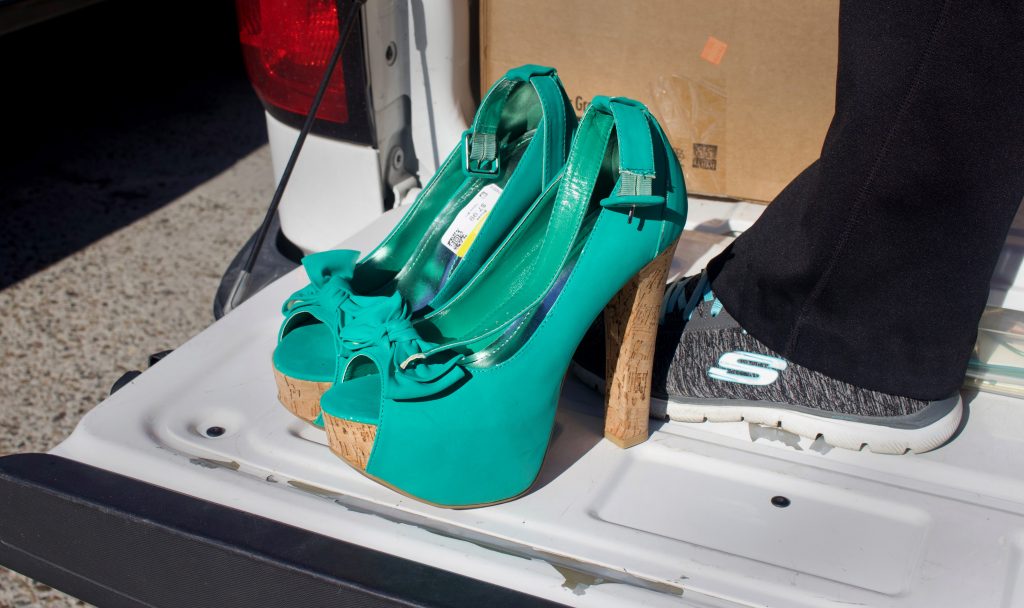A Hero Hiding in Plain Sight

Mayra Barros is a woman on a simple mission: to do what she can to help migrants seeking asylum in the United States. On a recent trip to Tijuana with the Caravan of Love, a bi-monthly shelter donation service organized by Border Angels, Barros volunteered her time and her pickup truck, which was full to the brim with donations. This included a sofa, an oversized stuffed dolphin, food, clothing, and one unlikely donation–– a pair of green stiletto heels.
Born and raised in Veracruz, Mexico, Barros obtained legal residency in the United States in 2018. She attributes her charitable nature to a Mexican tradition known as the “Posadas,” a religious re-enactment of Mary and Joseph’s search for a lodging in Bethlehem. Barros, a natural organizer, would recruit friends and neighbors to throw a celebration, which included piñatas, food, and decorations. “Above all, I loved seeing the children smile and forget about their problems. They weren’t interested in the food at all––in fact, all they wanted was the piñata,” she said.
While gathering donations in her hometown of San Bernardino, CA, Barros noticed a larger than average pair of green high heels and asked herself, “Who are these for? Who could use these at the shelters?” However, after learning that Tijuana had an LGBTQ friendly shelter named Casa Arcoiris (translated Rainbow House), she knew exactly what to do with them. In fact, the next day she went to the thrift store and found three more pairs of heels, several dresses, and nail polish to bring on her trip. Barros said she has many friends in Veracruz that identify as Lesbian, Gay, Bisexual, Transgender, or Queer/Questioning (LGBTQ), and that they would have loved those heels.
A Vulnerable Population
Upon arriving at the shelter, Barros and the other volunteers began unpacking donations and formed a human chain. They delivered cooking oil, plates, beans, clothing and the green stilettos, which were passed down the chain by volunteers and into the shelter. However, Barros was nowhere to be seen. Instead she waited patiently outside near her truck. Because of the risk LGBTQ migrants face, their identity and location must be carefully safeguarded, which limits the number of volunteers allowed inside the shelter. According to the United Nations High Commissioner on Refugees, “88 percent of LGBTI asylum seekers and refugees from the Northern Triangle reported having suffered sexual and gender-based violence in their countries of origin.” Ironically, many LGBTQ migrants have also fled the caravan due to violence, threats and assaults during their journey north–– forcing them to band together and travel separately.
At the shelter we met Pablo and Arturo, a young gay couple from El Salvador who’ve been together for over four years. During their journey through Mexico, they met Cassandra who is from Honduras, and decided to take her under their wings. All three of them have been living at Casa Arcoiris since December. When asked about the risks associated with near 2,500-mile tumultuous journey north, Cassandra said, “I put my faith in God, he guided me the whole way.” All three of them look like young college students who should be worried about things like ordering textbooks or obtaining their first job. Instead, they’ve traversed three countries in route to an uncertain future.
* Pseudonyms have been used to protect their identities.
As the sun began to set on the shelter, we noticed some custom planter boxes the residents have been painting in the back yard. They’re shaped like rainbow steps leading up to the sky, waiting to be seeded and watered. The heels, much like the plantar boxes, represent hope for a brighter, fuller, colorful future. Barros hopes the heels will bring its new owners joy and a taste of freedom as they navigate the next leg of their difficult journey.
